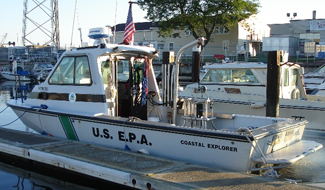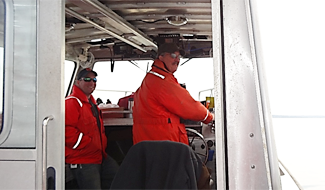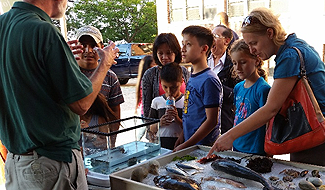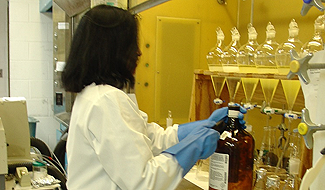About the Atlantic Ecology Division (AED) of EPA's National Health and Environmental Effects Research Laboratory
 AED’s Coastal Explorer.
AED’s Coastal Explorer. Scientists out on the water to conduct research.
Scientists out on the water to conduct research. AED scientist at an outreach event.
AED scientist at an outreach event. Scientist conducting research in the chemistry lab.
Scientist conducting research in the chemistry lab.What We Do
The Atlantic Ecology Division (AED), located in Narragansett, Rhode Island, conducts innovative research and predictive modeling to assess and forecast the risks of anthropogenic stressors to near coastal waters and their watersheds, to develop tools to support resilient watersheds and water resources, to inform decisions about sustainable management of nutrients, and to link environmental condition to the health and well-being of people and society. AED provides research support to EPA program and regional offices, state governments, and local communities.
AED conducts research in a variety of environments, including land, freshwater, estuarine, and nearshore marine environments, along the Atlantic coast. AED's mission is to develop the theory, methods, and data to improve understanding of human activity on coastal waters and watersheds. Special areas of research include:
- Methods, models, and tools to evaluate ecosystem services associated with coastal watershed and how they contribute to human well-being and social welfare, including developing quantitative and qualitative economic indicators of ecosystem service derived benefits, and developing methods to quantify tradeoffs among services resulting from management actions.
- Field and mesocosm studies to quantify the effects of nutrients, sea level rise, and climate-induced changes in weather patterns on coastal ecosystem resilience and sustainability, and to evaluate restoration approaches, recovery potential, and recovery trajectories.
- Methods and tools for determining and interpreting chemical effects in ecological receptors to support and improve ecological risk assessment, including exposure-response modeling, bioavailability and bioaccumulation of chemicals in water and sediment, synthesis of toxicity test results, and evaluating organism and population level effects of chemicals.
- Methods and models for determining the risks of nutrient-enhanced coastal acidification and hypoxia, including field and laboratory assessments and methods development.
- Data intensive scientific software, databases, web and mobile applications, and predictive models to predict and monitor the occurrence of cyanobacterial Harmful Algal Blooms (cHABs).
- Models of nutrient dynamics and effects linking watersheds to estuaries to inform decisions about sustainable nutrient management at landscape scales.
- Methods, tools, and indicators to inform decisions by communities concerning sustainable water resource use, and resilience to and mitigation of climate change impacts.
- Methods and analyses to assess the ecological condition of our Nation’s aquatic and wetland resources as part of the EPA’s National Aquatic Resource Surveys.
Organization
Wayne Munns, Director
